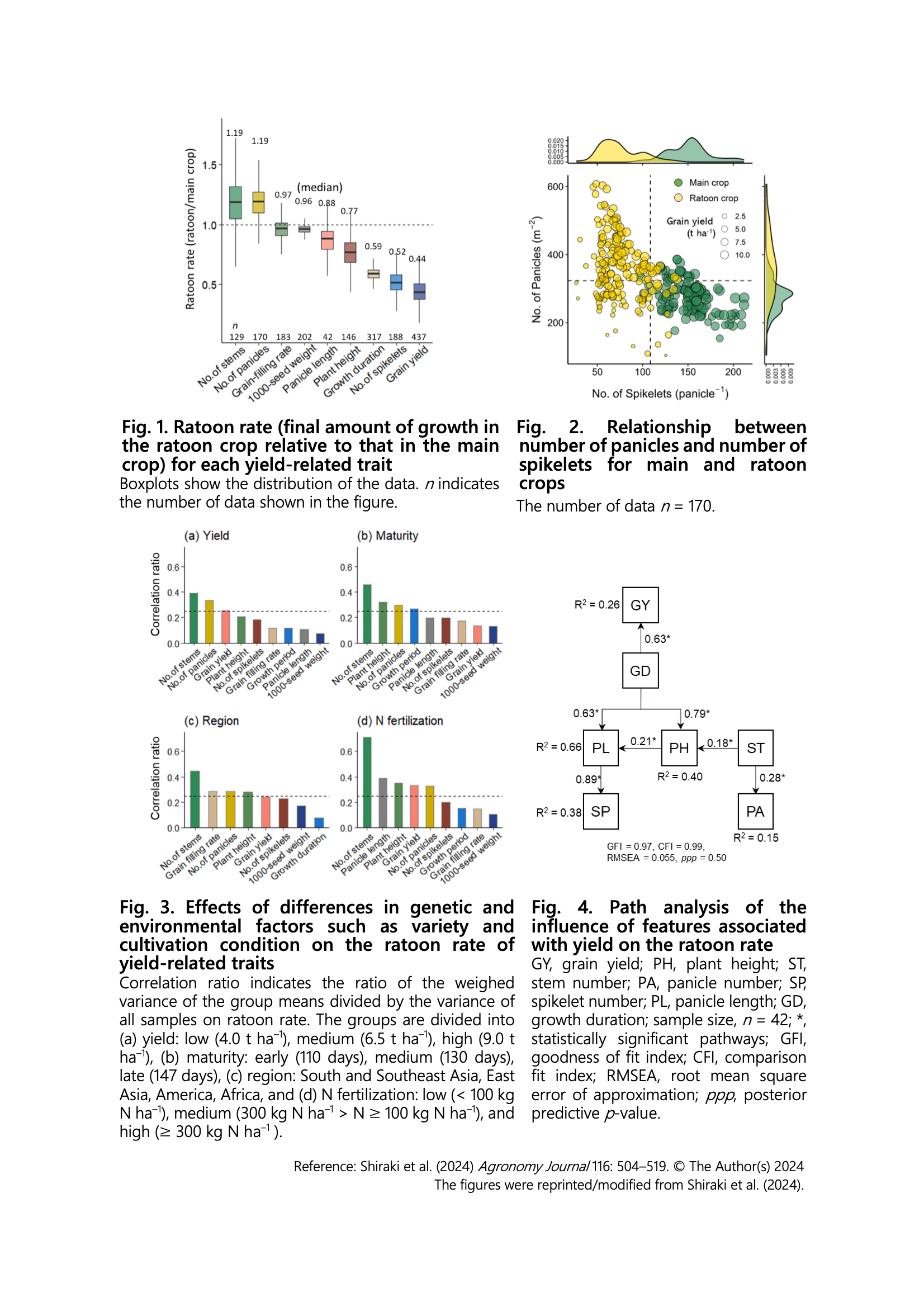Meta-analysis reveals general rice ratooning ability, and rice ratoon cropping shifts the plant type from panicle weight type to panicle number type
Description
Rice ratooning is a cultivation method that omits seedling raising, puddling, and transplanting and is therefore attracting attention as a low-input and low-cost method. However, it faces the challenge of significantly lower yields compared to conventional double-cropped rice. To address this, many studies have been conducted on the identification of varieties and traits with high ratooning ability. However, due to differences in genetic and environmental factors, there are various results from many studies, making it difficult to understand the ratooning ability of rice.This report uses statistical analysis of 51 field experiment data collected from 14 countries from 1976 to 2022 to examine the general ratooning ability, the effect of genetic and environmental factors on the ratooning ability of yield-related traits (plant height, number of stems, panicle length, number of spikelets, number of panicles, 1000-grain weight, grain-filling rate, growth period, and grain yield), and the relationship between ratooning ability and yield. In this study, ratooning ability is defined as the growth ratio of the ratoon crop to the main crop (ratoon rate).
The growth period of ratoon rice was 41% shorter than that of the main crop, and the number of spikelets and grain yield were significantly reduced by 48% and 56%, respectively, while the number of stems and panicles increased by only 19% (Fig. 1). This suggests that ratoon rice cultivation can accelerate heading, and the plant architecture shifts from the panicle weight type in the main crop to the panicle number type in the ratoon crop (Fig. 2). The influence of the number of stems in ratoon rice on ratoon rate was more variable and more susceptible to the effects of genetic and environmental factors such as variety and cultivation environment, while the number of spikelets, growth period, and 1000-grain weight were relatively less affected (Fig. 3). Path analysis between ratoon rates of each yield-related trait shows that growth period had a significant direct effect on grain yield, plant height, and panicle length, and that panicle length had a significant direct effect on the number of spikelets (Fig. 4). In other words, the results suggest that the shortening of the growth period of ratoon rice accelerates heading, which restricts the growth of the stem apex and the differentiation of young panicles that determine the number of spikelets, while the number of panicles does not increase significantly, resulting in a decrease in grain yield.
Figure, table
- Research project
- Program name
- KAKEN
- Term of research
-
FY2021-2023
- Responsible researcher
-
Shiraki Shutaro ( Rural Development Division )
Kywae ( Department of Agricultural Research, Myanmar )
Thura ( Department of Agricultural Research, Myanmar )
Lae Lae Mon ( Department of Agricultural Research, Myanmar )
Thin Mar Cho ( Department of Agricultural Research, Myanmar )
Kyaw Myaing ( Department of Agricultural Research, Myanmar )
Nwe Ni ( Department of Agricultural Research, Myanmar )
May That Oo ( Department of Agricultural Research, Myanmar )
Loon Poe Poe ( Department of Agricultural Research, Myanmar )
Aung Kyaw Thu ( Department of Agricultural Research, Myanmar )
- ほか
- Publication, etc.
-
Shiraki et al. (2024) Agron. J. 1–16.https://doi.org/10.1002/agj2.21521
- Japanese PDF
-
2023_A01_ja.pdf731.16 KB
- English PDF
-
2023_A01_en.pdf594.05 KB
* Affiliation at the time of implementation of the study.

